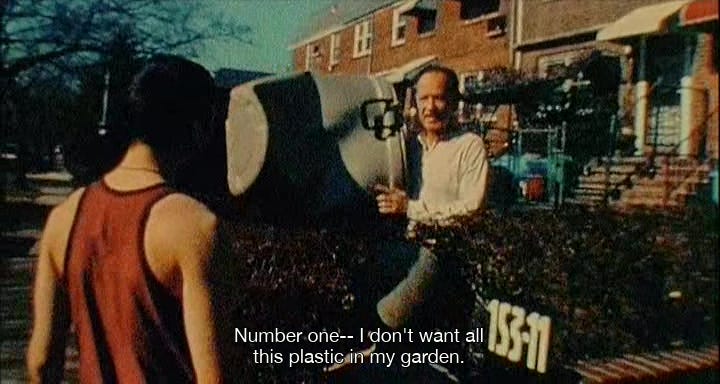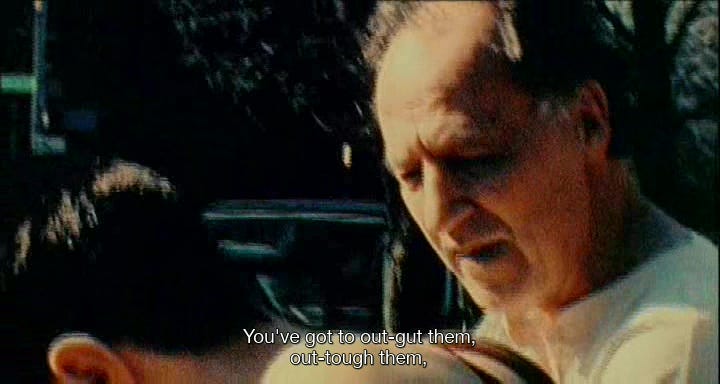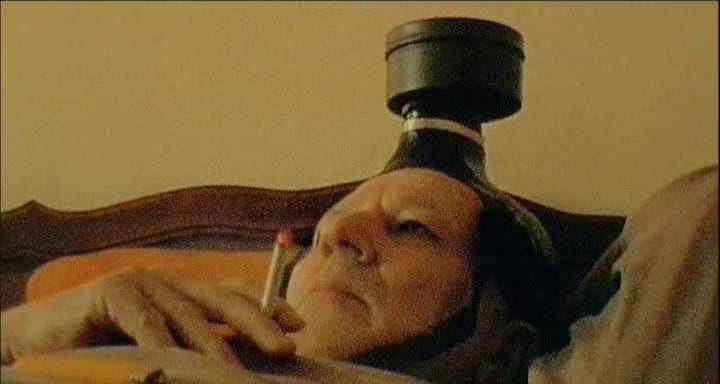◡◶▿ Bad dogma 25
📃 A Maya Deren-assed counter-manifesto to the latest Danish filmmaking counter-manifesto. Werner Herzog stuns in brutal Harmony Korine stills.

Dear eternal filmmaking students,
A load of Danish filmmakers published a new manifesto at Cannes. Great! Bit dry, though. So I’ve livened it up a bit.
The 10 ‘vows’ of their DOGMA 251 are pasted below. I have annotated them with my observations. And, in each case, my proposition for an alternative BadDogma 25 vow.
The Danish manifesto has a lengthy preamble, which I have not included here for reasons of space. You can probably imagine what it says.
I genuinely believe my alternative BadDogma 25 manifesto, written in 17 minutes, answers all the concerns of Danish DOGMA 25.
If you came here expecting a sustained and cohesive manual for overhauling your craft, sorry. You can check the school’s previous pages for that sort of business! But if you find yourself in a filmmaking corner, try one or more of these bad dogma bones to shake yourself out - and let me know how it goes.
BadDogma 25 (Incorporating DOGMA 25)
The Danish DOGMA 25 manifesto in bold. My notes in italic. The UPV BadDogma 25 counter manifesto in bold-italic.
“THE VOW OF CHASTITY: I vow to submit to the following set of rules drawn up and confirmed by DOGMA 25:
1. The script must be original and handwritten by the director. We compel ourselves to write the script by hand in order to nurture the kind of intuition that flows most freely from the dream, channelled through the hand onto the paper.
Please don’t share your dreams. Better to write your script in the sand with your toes. This will engage your body below waist level, force you to compose your script with poetic economy, and get you out of the house.
Alternative Vow 1. Write the script in the sand with your toes, the crabs your fiercest critic and motivator.
2. At least half the film must be without dialogue. We insist on a cinematic approach to filmmaking, because we believe in visual storytelling and have faith in the audience.
This rule overlooks:
silence-as-dialogue,
dialogue as soundscape, and
the artistic power of *sonic* “storytelling” in the cinema.
We also face a practical question. In what direction should the film be halved before applying the dialogue to it?
Conventional thinking would have us halve it temporally: the first half or the second half should be without dialogue, or every other minute should be without dialogue.
Why not a visual division? The top half of the image usually gets all the dialogue, right? How about “all dialogue must be emitted from the lower half of the image?” Or 50% of the characters must be mutes. Perhaps only half the frequency spectrum should have dialogue. Or three of the six 5.1 surround sound channels.
Alternative Vow 2. Only the objects are audible. Not so much as a breath from the humans. Object dialogue is permissible. And object breath.
3. The internet is off limits in all creative processes. We commit to produce the films relying on real people within our physical reality – rather than in a digital one infused with algorithms.
Can’t believe it’s 2025 and we’re still distinguishing “physical” reality from “computer” reality. The only way to honour this vow with any charm is to absolutely corporealise the digital; to rediscover the blood, muck, dust, and bedsores of digital interaction.
We’re also going to need to ringfence what we mean by “creative processes.”
Alternative Vow 3. Everyone involved in the film must print their unedited browser history and hide it on set each morning before pastries. At lunch, all are to discuss what they’ve found and feed it back into the creative process.
4. We’ll only accept funding with no content altering conditions attached. We assume responsibility for keeping budgets down so the team retains final say in all artistic decisions.
This already exists, it’s called no-budget filmmaking, and the results are often startlingly unoriginal.
Alternative Vow 4. Accept every suggestion you hear - from your producer, your biological and sugar daddies/mamas, and your taxi driver. For therein lies the idiotic logic by which real life is organised and our culture has blossomed.
5. No more than 10 people behind the camera. We commit to working in close collaborations to build trust and strengthen our shared vision.
Easily skirted by casting the crew as characters or camouflaging them and hiding them in the picture. If you’re really serious about getting out of the safe zone, put your boom operator in the shot.
Alternative Vow 5. Have as many crew as you need, but they must be on screen at all times. Even if we can’t see them. Only the actors are allowed to cross the line to switch off the camera or operate heavy machinery. The editor should record the ambience of her edit suit in operation (including mumbling, farting, and smalltalk) and paste it into the film’s soundscape without self-censorship.
6. The film must be shot where the narrative takes place. Film as an art form becomes artificial and generic when we portray a location in a false light.
Putting my affection for the artificial and generic (and for false light) aside, this is another vow that requires some terms to be defined.
In particular, what do you mean by location and how do you know where the narrative really takes place? Which narrative?
Rather than settling for the surface ‘reality’ of your locations, I would advise all filmmakers to interrogate both their scripted and scouted locations to expose their deeper truths and artifices. And interpret them on-screen using whatever tools of filmmaking are most effective in the situation.
And don’t forget that scouting for a location is itself an act of artifice. The truth dances in daft disguises. Don’t mistake your earnest sensibility for a divination of reality.
Alternative Vow 6. Put your locations in drag.
7. We’re not allowed to use make-up or manipulate faces and bodies unless it’s part of the narrative. Just as we strive to maintain the authenticity of the location, we also want to portray the human body without a filter. We celebrate it – warts and all.
Sadly, submitting to such an anthropocentric view of cinema and storytelling is a concession to the very forces that DOGMA 25 seeks to refute.
Your main character is light, and light is also the primary make-up and personal trainer of each of your actors.
This vow also concedes to the long-dismissed myth that the photographed-here-and-now in some way equates to “reality.”
Alternative Vow 7. You’re not allowed to use make-up or manipulate faces and bodies BUT every actor must self-identify their most despised physical flaws (warts and all) and assign each its own discrete character. Each actor must switch between their multiple flaw-characters throughout the movie, without - let me remind you - adding make-up or prosthetic thingamajigs.
8. Everything relating to the film’s production must be rented, borrowed, found, or used. We commit to making films using objects that already exist and renounce the ahistorical and self-destructive culture of consumerism.
First thought: Does this also apply to the catering department? Has there ever been a Danish film crew that was forage fed?
Anyway, recycling and upcycling is all good for the screen. However, this vow offers a rather sober view of resourcefulness. I’m torn, here, between vowing that only found objects can be used but they CANNOT play themselves (they must be reimagined or recombined into new objects) or:
Alternative Vow 8. Everything relating to the film’s production must be stolen.
…I’ll let your conscience decide.
9. The film must be made in no more than one year. We abstain from any lengthy processes that stand in the way of creative flow.
Impossible!
I’ve been thinking, for a while, of a film that updates itself. A Vimeo link or whatever to which new cuts or scenes can be added with release notes. Even better if multiple crew members (but neither the actors nor composer, for obvious reasons) have editing access.
The finished film itself is live and pending updates from the moment of conception.
Alternative Vow 9. Release everything now. Never finish. Tether your eternal publicity to the tides of your enthusiasm.
10. Create the film as if it were your last.”
Surely all but the most jaded or arrogant do this, anyway.
Alternative Vow 10. Create the film as though Roger Corman has commissioned you to make eight of these movies in the next two months and you’re half way through the process. (Create at least one additional secret film during production of your manifesto film, and don’t tell Roger!)
Afterthoughts
A manifesto tends to begin life as a rail against something, even if it manifests as instructions towards a positive outcome.
It is not a huge leap to assume that in their identification of targets, a manifesto writer can’t help but identify their worst criticisms or fears about themselves.
I have kindly chosen not to analyse the Dogma 25 authors’ neuroses from their manifesto.
I have attempted not to self-censor when my counter-vows have leaked my own inner turmoil onto the page.
Long-term UPV students will have noticed that ‘regular emails’ did not recommence after the spring break. Perhaps they will after the summer break. “It’s a mystery to me.”
Your missing professor & loving Principal,
~Graeme Cole.
📹 Unfound Peoples Videotechnic | Cloud-based filmmaking thought. ☁️
🦋 Bluesky | 📸 Instagram | 😐 Facebook | 🎞️ Letterboxd | 🌐 Website
They’ve called it DOGMA 25 in the spirit of Dogme 95: the fin-de-siècle filmmaking manifesto Lars Von Trier and friends printed onto red paper and tossed from the balcony of a Parisian state-of-the-artform symposium in, well, 1995. Lars Von Trier and friends have given this rethinking their blessing, which seems like a missed opportunity for mischief.







Love your fun and honest manifesto. But tbh, ditch manifesto anyway.
Splendid as always! 👌